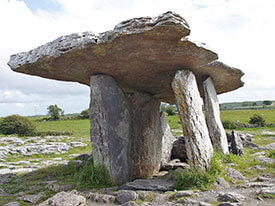Warfare, Gravestones, and the Megalithic Cult of the Dead
Richard A. Koenigsberg |
|||
Archaeologists theorize that dolmen are tombs or burial chambers. Human remains, sometimes accompanied by artifacts, have been found in or close to them. Eliade suggests that these gigantic structures are burial places, conveying a very important “cult of the dead.” Whereas the houses of the Neolithic peasants who made these monuments were modest and ephemeral (and in fact have left almost no trace), the dwellings for the dead were built of stone. It is obvious, Eliade says, that the intention of the people who created these monumental structures was to construct “imposing and solid works” capable of resisting time. The rock, the slab, the granite block reveal “duration without end, permanence, incorruptibility:” a modality of existence independent of temporal becoming. Eliade suggests that these stones constituted a “substitute body” in which the souls of the dead were incorporated. The stone substitute represented a “body built for eternity.” The idea was the transmutation of the ancestors into stone by incorporating an essential element of the dead person—skeleton, ashes, “soul”—into the actual structure of the monument. Gravestones or monuments erected to honor dead soldiers are not unlike these megalithic structures. The remains of dead soldiers are incorporated in a grave, producing a tombstone—symbolizing the continued existence of the soldier. The soldier’s body becomes a slab of rock. The stone symbolizes a body that will live forever. The rock can live forever—because it is already dead. The objective of warfare (battle) is to transform human bodies into slabs of stone. Gravestones or national monuments symbolize the bodies of soldiers—resurrected as a pieces of stone. These memorials dot the landscape in places like Australia and the Western Front in France, testifying to the reality of these nations. Witnessing the tomb or gravestone, we reflect that the soldier died for his country. Surely he could not have died for nothing (in vain). The gravestone persuades us that our nation exists. Eliade theorizes that the human beings who built the dolmens hoped that the names of his ancestors would be “remembered through the agency of stone.” The memory of and connection to the ancestors is assured by a memory “fixed in the megaliths.” By virtue of these megalithic structures, “the dead enjoy exceptional power.” War memorials represent our connection to national heroes whose sacrificial deaths gave rise to our nation—and the sacred values for which the nation stands. Memorials raised in honor of those who have died for their country impose obligations on future generations, who must be willing to sacrifice themselves, in turn, for the sacred values for which human beings of a previous generation have given their lives. Richard A. Koenigsberg, PhD: (718) 393-1081 |
 The Poulnabrone Dolmen (Ireland)
The Poulnabrone Dolmen (Ireland)